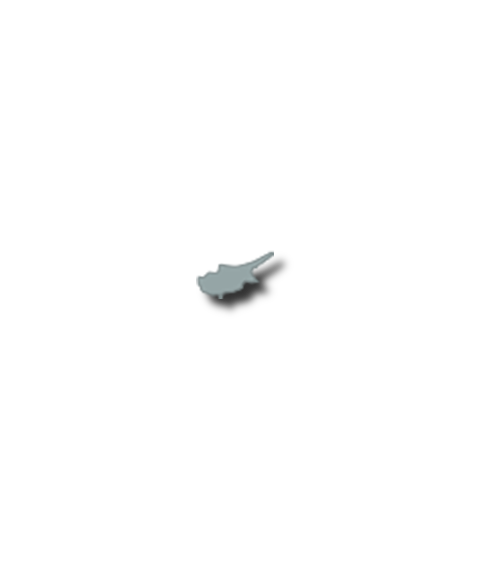Cyprus |
|
|
Select by country / Cyprus |
| Capital: |
Nicosia |
|
 |
| Population: |
1.19 Million |
| GDP per capita: |
€ 37.4 Thousand |
| |
| National Film Fund: |
No |
| Regional Film Funds: |
No |
| |
| National Film Commission: |
No |
| Incentive: |
No |
| |
Cyprus is the third largest island in the Mediterranean Sea, after the Italian islands of Sicily and Sardinia[4] (both in terms of area and population). It is also the world's 80th largest by area and world's 51st largest by population. It measures 240 kilometres (149 mi) long from end to end and 100 kilometres (62 mi) wide at its widest point, with Turkey 75 kilometres (47 mi) to the north. It lies between latitudes 34° and 36° N, and longitudes 32° and 35° E.
Other neighbouring territories include Syria and Lebanon to the east (105 and 108 kilometres (65 and 67 mi), respectively), Israel 200 kilometres (124 mi) to the southeast, Egypt 380 kilometres (236 mi) to the south, and Greece to the northwest: 280 kilometres (174 mi) to the small Dodecanesian island of Kastellorizo (Megisti), 400 kilometres (249 mi) to Rhodes and 800 kilometres (497 mi) to the Greek mainland. Sources alternatively place Cyprus in Europe, or Western Asia and the Middle East.
The physical relief of the island is dominated by two mountain ranges, the Troodos Mountains and the smaller Kyrenia Range, and the central plain they encompass, the Mesaoria. The Mesaoria plain is drained by the Pedieos River, the longest on the island. The Troodos Mountains cover most of the southern and western portions of the island and account for roughly half its area. The highest point on Cyprus is Mount Olympus at 1,952 m (6,404 ft), located in the centre of the Troodos range. The narrow Kyrenia Range, extending along the northern coastline, occupies substantially less area, and elevations are lower, reaching a maximum of 1,024 m (3,360 ft). The island lies within the Anatolian Plate.
Cyprus contains the Cyprus Mediterranean forests ecoregion. It had a 2018 Forest Landscape Integrity Index mean score of 7.06/10, ranking it 59th globally out of 172 countries.
Petra tou Romiou ("Rock of the Greek"). Geopolitically, the island is subdivided into four main segments. The Republic of Cyprus occupies the southern two-thirds of the island (59.74%). The Turkish Republic of Northern Cyprus occupies the northern third (34.85%), and the United Nations-controlled Green Line provides a buffer zone that separates the two and covers 2.67% of the island. Lastly, two bases under British sovereignty are located on the island: Akrotiri and Dhekelia, covering the remaining 2.74%.
|
Cyprus
GDP per capita:
€ 37.4 Thousand
National Film Commission:
No
Cyprus is the third largest island in the Mediterranean Sea, after the Italian islands of Sicily and Sardinia[4] (both in terms of area and population). It is also the world's 80th largest by area and world's 51st largest by population. It measures 240 kilometres (149 mi) long from end to end and 100 kilometres (62 mi) wide at its widest point, with Turkey 75 kilometres (47 mi) to the north. It lies between latitudes 34° and 36° N, and longitudes 32° and 35° E.
Other neighbouring territories include Syria and Lebanon to the east (105 and 108 kilometres (65 and 67 mi), respectively), Israel 200 kilometres (124 mi) to the southeast, Egypt 380 kilometres (236 mi) to the south, and Greece to the northwest: 280 kilometres (174 mi) to the small Dodecanesian island of Kastellorizo (Megisti), 400 kilometres (249 mi) to Rhodes and 800 kilometres (497 mi) to the Greek mainland. Sources alternatively place Cyprus in Europe, or Western Asia and the Middle East.
The physical relief of the island is dominated by two mountain ranges, the Troodos Mountains and the smaller Kyrenia Range, and the central plain they encompass, the Mesaoria. The Mesaoria plain is drained by the Pedieos River, the longest on the island. The Troodos Mountains cover most of the southern and western portions of the island and account for roughly half its area. The highest point on Cyprus is Mount Olympus at 1,952 m (6,404 ft), located in the centre of the Troodos range. The narrow Kyrenia Range, extending along the northern coastline, occupies substantially less area, and elevations are lower, reaching a maximum of 1,024 m (3,360 ft). The island lies within the Anatolian Plate.
Cyprus contains the Cyprus Mediterranean forests ecoregion. It had a 2018 Forest Landscape Integrity Index mean score of 7.06/10, ranking it 59th globally out of 172 countries.
Petra tou Romiou ("Rock of the Greek"). Geopolitically, the island is subdivided into four main segments. The Republic of Cyprus occupies the southern two-thirds of the island (59.74%). The Turkish Republic of Northern Cyprus occupies the northern third (34.85%), and the United Nations-controlled Green Line provides a buffer zone that separates the two and covers 2.67% of the island. Lastly, two bases under British sovereignty are located on the island: Akrotiri and Dhekelia, covering the remaining 2.74%.

